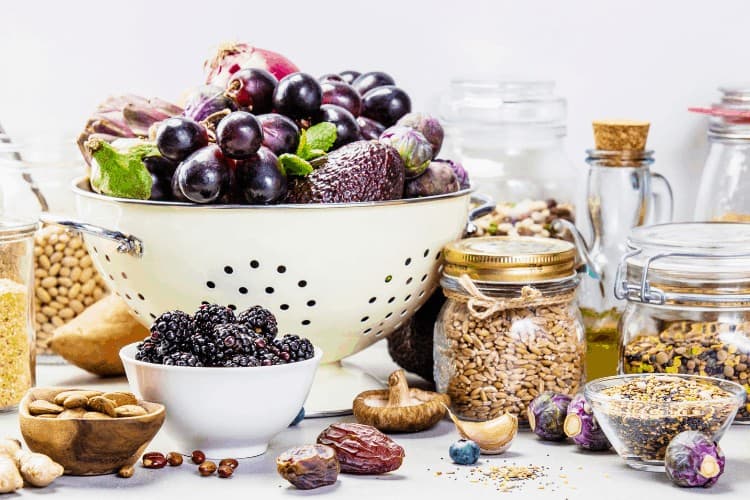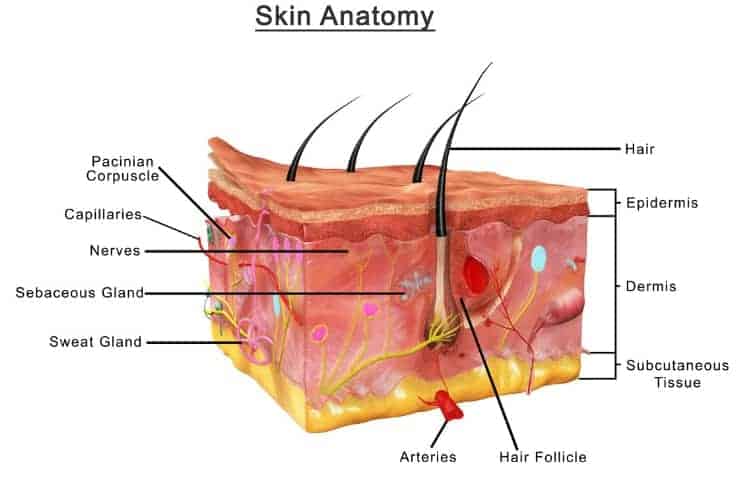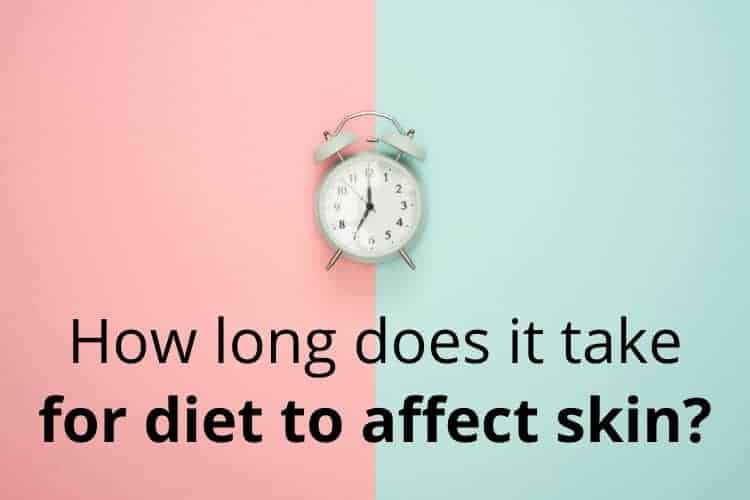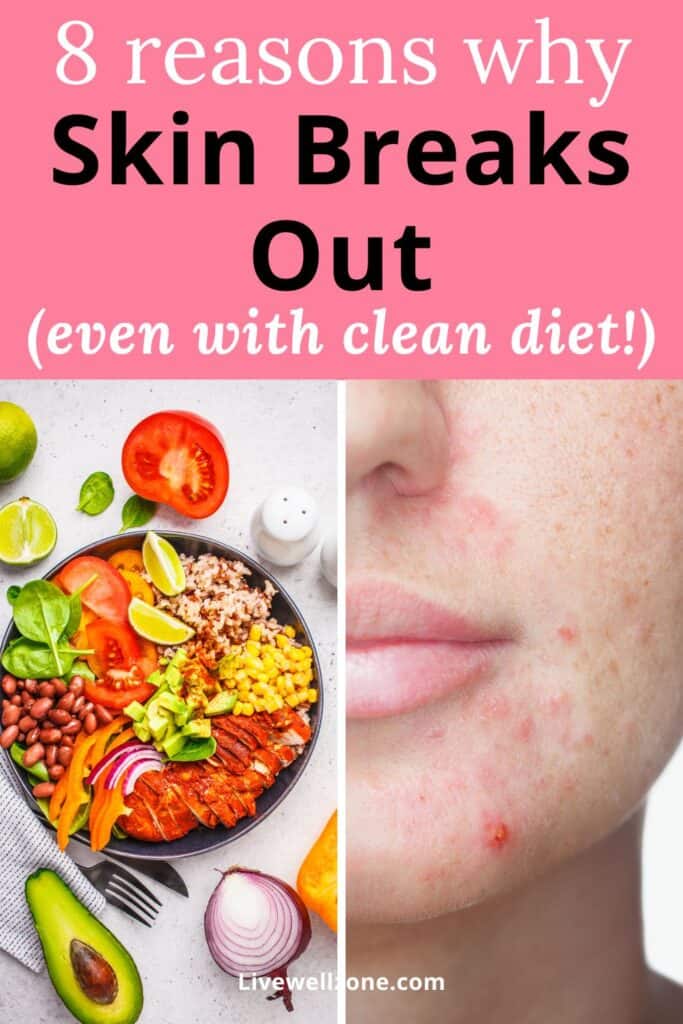
So you’ve been doing all the things to clear up your skin including, changing your diet. Maybe you’ve cut out the usual suspects like refined sugar, white rice or white bread. And yet, you’re still breaking out, leading you to wonder “why is my skin bad when I eat healthy?”
Well, I’ve done some investigating for you and here’s the deal:
Eating healthy can make your skin worse because there are many variances in terms of what a healthy diet looks like. With so many options to choose from – keto, paleo, low GI, vegan, lacto-vegetarian and so on – you can end adopting a diet that inadvertently creates imbalances in the body and contributes to more breakouts.
But now the real question is clean eating useless when it comes to your skin? Should you just give up on dietary changes and rely on that 10-step skin care routine instead?
We’re going to dive into all of these questions and much more in this article.
Let’s start off by looking at the skin and how it actually receives nutrients.
DOES EATING HEALTHY AFFECT YOUR SKIN?
Because the epidermis (outermost layer of our skin) is what we see every day, it’s easy to think that topical products are the only things that affect it. And while that is partially true, that’s not the whole story. What we eat also affects the skin.
You see, skin is made up of three main layers, and each layer plays it role, particularly when it comes to nutrients. Let’s have a quick look (source):

THE EPIDERMIS
- outermost layer of skin, responsible for protecting your body from the environment and for producing melanin.
THE DERMIS
- located beneath the epidermis; it’s the thickest of all the layers.
- contains blood vessels that supply oxygen and blood to the epidermis. Since blood carries nutrients, this means the vessels within the dermis are how the outer skin gets “fed.” These blood vessels also carry away waste that would otherwise ruin the skin.
- Contains lymph vessels that supply lymphatic fluid, responsible for combatting foreign organisms that could harm the skin.
SUBCUTANEOUS TISSUE OR SUBCUTIS
- The blood and lymph vessels that are in the dermis also cross the subcutis. So, the subcutis is also essential for ensuring that the right nutrients make it all the way up to the epidermis.
As you can see, the skin is designed to get its nutrients from blood, which carries the nutrients from the foods we eat.
So, if you eat a nutrient-dense diet, those nutrients make it into the bloodstream. And that same blood is what gets transported through the subcutis, dermis and finally, to the epidermis.
On the other hand, if your diet is lacking in certain nutrients and/or contains too many unhealthy, processed foods, then that’s what will end up in your bloodstream. And ultimately, that is what will end up being sent to the epidermis.
I EAT HEALTHY AND STILL GET ACNE: HERE’S WHAT’S REALLY GOING ON
The major issue with “eating healthy” is that it means different things to different people. And unfortunately, many popular diets and foods that are considered “healthy” can actually contribute to inflammation.
Now, why does this matter for acne? Well, acne is an inflammatory condition and as I explained in a previous article, inflammation in the body can trigger acne.
So, if you eat healthy and still have acne, it’s possible that your diet is inadvertently triggering inflammation, or your diet isn’t addressing all aspects of pre-existing inflammation.
8 REASONS WHY YOUR SKIN IS WORSE EVEN WITH A HEALTHY DIET
1. Consuming Low Fat Dairy
Although eating low fat dairy may sound like a good idea, conventional (non-organic) dairy comes from cows that have usually been given antibiotics and growth hormones. These two things are problematic because:
- antibiotics can affect the balance of our gut bacteria, contributing to leaky gut syndrome and inflammation. Any imbalance in the gut can potentially affect our hormones, and subsequently, the health of the skin as well.
- there are concerns that trace amounts of growth hormones can make it into dairy products. Because these hormones are meant for cows, and not humans, long-term of consumption of these dairy products may also affect our natural hormonal function.
Overall, leaky gut, hormonal imbalance and inflammation can develop. And that inflammation can show up on your skin in the form of acne.
2. Soy Products
Soy milk and tofu are two popular, plant-based protein alternatives. However, because over 90% of the soy in the U.S. is genetically modified, that means it’s been sprayed with a lot of pesticides.
That pesticide residue can interfere with the natural function of any number of female hormones, ultimately, contributing to hormonal imbalance and acne.
3. Gluten-Containing Foods
First off, let’s be clear about one thing: wheat – which is the main source of gluten for many people – isn’t inherently bad. However, some people can be sensitive to gluten, and this will also contribute to inflammation (source).
In addition, there are changes in farming practices, particularly when it comes to how gluten is processed and subsequently used in baked goods. Some experts believe that these farming changes play a role in how our bodies respond to gluten.
If you’re curious to learn more about this, here’s a report that presents some interesting points worth thinking about:
4. Nutrient Deficiencies
These days “healthy” doesn’t mean “balanced.” Rather, it means low carb, high fat, high protein, low calorie and everything in between.
Unfortunately, many modern philosophies of healthy eating involve serious restrictions of food groups that are essential for human life.
So, by reducing carbs, fats or protein, we also end up missing out on dozens of other nutrients that are in those foods. And even when we try to compensate by taking supplements, that may not always work because whole food also contains other components that can’t be bottled up.
NOTE: there are medical conditions or situations where there might be a need to cut out an entire food group temporarily or permanently. That’s a special situation. What I’ve outlined above applies to food restriction that isn’t medically necessary.
5. Severe Calorie Restriction
Sometimes, a well-intentioned desire to lose weight can lead to severe calorie restriction. We’re talking 1200 calories or less per day.
Now to put it in perspective, 1200 calories falls in the range of what a toddler needs for their optimal function (source).
As adults we need more than that for optimal function.
So, what happens if calories are too low? Your body is working at a deficit and this can put added strain or stress on your health.
Stress is the trigger for inflammation and elevated cortisol, both of which can worsen acne.
6. Gut Health Issues
In order to properly breakdown and absorb nutrients from food, or supplements, you need a healthy gut.
So if you have an underlying gut issue – like leaky gut or an imbalance in your gut flora – it’s important to address it.
Otherwise, you can end up in a vicious cycle of trying out a new healthy diet, and yet, still struggling with skin problems.
Also, it’s important to note that food intolerances are often related to having an unhealthy gut. Those intolerances increase inflammation and cortisol (a hormone that triggers the skin to produce more sebum).
So, once again, taking care of the gut is an important part of addressing the root causes of skin issues.
7. Not Enough Plant Protein
For many of us, getting enough protein is a priority. And that often means eating animal protein.
Unfortunately though, animal protein is pro-inflammatory (1, 2, 3). So, when cleaning up your diet for skin care, it’s important to give higher priority to plant sources of proteins.
This means foods like:
- nuts.
- seeds.
- lentils.
- beans.
- chickpeas.
8. Stress-Filled Lifestyle
Sometimes we forget that our sleep, work schedule, exercise (too much or too little), skin care products and other aspects of our life contribute to stress and inflammation.
The fact is, each person is different and unique. And sometimes the thing that’s triggering acne isn’t diet-related.
Rather it’s lifestyle-related.
Maybe you’re very sensitive to certain chemicals in your beauty products. Or maybe you’ve been coping with emotional stress for such a long time that you don’t even realize the toll it’s taking on you.
Our skin reflects back a lot of what’s going on in our lives. So, if you’re doing everything right as far as diet, but you still have acne, consider doing a lifestyle audit. The answer just might lie there.
HOW LONG DOES IT TAKE FOR DIET TO AFFECT SKIN?

Skin cells renew themselves about every 27 days (source). So, this means that when making any dietary changes, it’s a good idea to give it at least that amount of time before trying to evaluate the effectiveness (or not) of the diet.
Do keep in mind that the current condition of your skin, plus the type of dietary changes you’re making, both play a role in how long it takes to see visible improvements.
In my work as a health coach, some of the women I work with have reported having a healthier glow within a few days of tweaking their diets.
But if we’re talking about chronic acne, it can take months for dietary changes to really take effect.
FAQs ABOUT WHY CLEAN EATING CAN MAKE SKIN WORSE
What can you eat or drink to clear your skin?
Some of the best foods you can eat for clear skin are nutrient-dense and antioxidant-rich foods that combat inflammation. The main categories are whole fruits and veggies, gluten-free grains, raw nuts and seeds, as well as any fresh herbs (parsley, cilantro, rosemary, etc.) that you enjoy.
As for drinks, water is queen! Aimig for 1 liter a day will help you hydrate your skin while also flushing out waste.
In addition to water, reach for smoothies, fresh pressed juices, herbal teas and fermented drinks (such as kefir).
How can I get clear skin at home?
Aside from a healthy diet, having a more natural skin care routine at home is helpful for clear skin. In fact you can build a no-fuss, yet effective skin-clearing routine with just a carrier oil, clay powder (such as kaolin or bentonite), essential oils and a natural soap (or soap-free cleanser).
CONCLUSION
As you can see healthy eating – depending on what it means to you – can improve your skin…or make it worse.
Now, I know that might be very frustrating and leave you feeling more confused.
But remember this: the medical community categorizes acne as an inflammatory condition.
So, whenever you’re in doubt about your diet, take a moment to evaluate whether the foods are anti-inflammatory or not.
And as we saw earlier, don’t underestimate the role of lifestyle in all this as well.
Taking a holistic approach is really essential for real, lasting skin transformation.

You Might Also Enjoy:
Everything You Need To Know About Chamomile Tea vs Green Tea for Acne
Seed Cycling for Acne: Benefits and How To Get Started
Vegan (& Vegetarian) Meal Plan for Clear Skin: Fun, Easy, Tasty Recipes!
How Much Water Should I Drink To Get Rid Of Acne? The Answer May Surprise You
What No One Is Telling You About Stevia and Acne
How To Make The Best Anti-Acne Smoothie To Give Your Skin New Life
Peppermint Tea vs Spearmint Tea for Acne: Which Is Better?
Is Chamomile Tea Good For Acne?
What To Do Before And After Steaming Your Face: A Complete Guide

